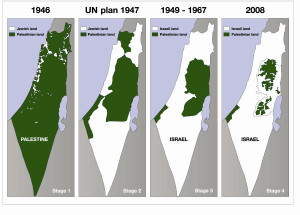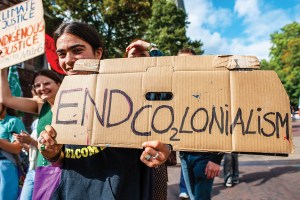Israel’s assault on Gaza, using U.S.-supplied weapons, constitutes a hurtle toward ecocide.
Ecocide in Palestine/GAZA
Not only are people dying of starvation, dehydration, disease, injury, sniper fire, drone and bomb attacks but Gaza’s natural and cultural environments are destroyed. Photo: Unicef
by Carol Masters Women Against Military Madness Newsletter, Vol. 42, No. 1, Spring 2024
The U.S.-supported military occupation in Israel has a devastating effect on the Palestinian people, but it also causes radical changes in the natural world.
This is evident in the desertification of parts of the Jordan Valley in the West Bank. It’s the outcome of Israel’s intentional policy to create a constant, artificial shortage of water for Palestinians.
Indigenous people have traditionally acted as stewards of the land on which they depend for their livelihoods. Bedouin shepherds grazed their flocks of sheep in this region. However, Israel controls all the water sources and diverts most of them to Israelis. The natural water sources and vegetation the Bedouin need have been rapidly disappearing, along with more and more of the land usurped by Israelis for building settlements and by the Israeli Defense Force commanding it for military firing ranges.
The International Committee of the Red Cross (ICRC) reported on “settler expansion and the imposed restrictions on natural water sources”. Mahdi Daraghmeh, a member of the Bedouin community of Wahdi Al-Maleh recalled to the ICRC that “there were 11 springs in the past and most of them dried up, whether from climate change or settler expansion.”
“Our biggest problem is water. We watch every drop and save it for our flock, which cannot survive for a minute without water. If we don’t do laundry, and don’t shower, and don’t wash dishes, we’ll get sick because of bacteria and rodents,” says Yusef Bsharat from the village of Khallet Makhul.[1]
In another and very different part of Palestine, the genocidal bombardment of the densely-populated Gaza Strip caused 85% of the population to flee from the north to the south or be subject to further attack. 1.7 million Palestinian people were displaced – many of them forced to crowd together, eventually in Rafah (population 275,000) near the Egyptian border. Weakened from exhaustion, starvation, dehydration, injury, and assaulted in additional attacks, the traumatized population began to experience the spread of disease.
Israel’s assault on Gaza, using U.S.-supplied weapons, constitutes a hurtle toward ecocide.
[2] Stop Ecocide International defines ecocide as “broadly understood to mean mass damage and destruction of ecosystems – severe harm to nature which is widespread and long term.” Further, the organization’s panel of independent law experts proposes that ecocide be categorized as a war crime: “unlawful or wanton acts committed with knowledge that there is a substantial likelihood of severe and either widespread or long-term damage to the environment being caused by those acts.” [3]
 Paypal/Card Other Options
Paypal/Card Other Options
Support Independent Media
Mazin Qumsiyeh, founder and director of the Palestine Museum of Natural History and the Palestine University of Biodiversity and Sustainability at Bethlehem University, (endnote) working in the fields of genetics and biology in the U.S. and in most recent decades in Palestine, has a concern for sociologic, humanitarian applications. He says that “in nature, when a forest is dominated by one species, it is a forest in decline.” He explains how in natural systems, at high levels of disturbance such as frequent forest fires or effects like deforestation, all species are at risk of going extinct. The beauty of humanity is its diversity: the horror of genocide happens when peoples think somehow they are “better” than other cultures and attempt to destroy diversity.[4]
The environment is being destroyed at a slightly slower pace in the West Bank, but in Gaza, it will be difficult to sustain Palestinian life at all in Gaza.
The very air for those trapped in Gaza has become unbreathable. As Israel’s assaults continued in February, in addition to “the pollution caused by Israel’s weapons [read: U.S. weapons], the air in Gaza has been fouled by the widespread burning of wood and other material” in the streets, for displaced people to keep warm and to cook what little food is still available.[5]Nasreen Tamimi, the head of the Palestinian Environmental Quality Authority, says, “The environmental impact of the war on Gaza is catastrophic” and that “the martyrs’ bodies under rubble, hazardous medical waste, the shutdown of treatment and desalination plants have all contributed to the current crisis…”[6]
By destroying essential infrastructure, Israel has targeted the environment. Most water supplies in Gaza are pumped from a coastal aquifer, already becoming undrinkable because of outdated and damaged infrastructure. Without Gaza’s water and sewage treatment facilities—and with airstrikes ongoing— sewage is flowing into the Mediterranean, with dire consequences.
A recent report by Human Rights Watch documents the use of white phosphorus in military operations in Gaza and Lebanon, severely damaging to the ecosystem. And since many Gazans depend on fishing as a source of food and income, contaminated waterways impact the water, the fish, and people’s health and livelihoods. Agricultural land, a source of food, also becomes contaminated.
According to the report, “The military detritus will continue to live in the soil, the earth, the sea and the bodies of the Palestinians living in Gaza—just as it does in other postwar contexts such as Iraq.”[7] Thanks in part to pressure from the U.S. and its militarism establishment, the climate consequences of war and occupation are underreported and poorly understood.
Climate Change
The Eastern Mediterranean is already among the world’s regions most vulnerable to climate change, which does not recognize borders. Managing climate change will be especially hard for Palestine, where Israeli policy has effectively engineered elevated vulnerability. Israel and Palestine are part of the Mediterranean Basin biodiversity hotspot—but Gaza is in a weaker position than ever before.
Climate crisis is a reality worldwide but the genocide on Gaza is exacerbating the global climate emergency. Besides the immediate human suffering, according to Nina Lakhani, the climate reporter for The Guardian, a study showed that the climate cost of the first 60 days of Israel’s military attacks is equivalent to burning at least 150,000 tons of coal. She wrote this “includes CO2 from aircraft missions, tanks and fuel from other vehicles, as well as emissions generated by making and exploding the bombs, artillery and rockets.” Almost half the total CO2 emissions were from U.S. cargo planes flying military supplies to Israel. As it was only possible for scientists to take a limited amount of samples, Lakhani estimates that the damage would probably have been much greater than found in the original reports. As of this writing, more than twice as many days have passed, so the damage would be even greater.[8]
“This is my beautiful Gaza, this is my beautiful street. Not only is their famine in Gaza, but sewage water is everywhere, which is increasing the spread of diseases!” – from Dalloul Neder on X, Feb. 27, 2024
Environmental injustice in one locale can affect the whole world. Annexing the Jordan Valley and building beachfront villas in Gaza on ethnically-cleansed land may be the dream of some, but ecocide renders it an uninhabitable nightmare for anyone. The sustainability of nature and the beauty of humanity is in its diversity, as Mazin Qumsiyeh says.
Carol Masters is a member of the WAMM Newsletter Committee and a long-time WAMM member. Mary Beaudoin contributed to this article.
ACTION:
Join the weekly Vigil to End the Occupation of Palestine. Every Friday 4:00 to 5:00 p.m. at the corner of Summit and Snelling Avenues, St. Paul. For more information: 612-827-5364
Additional resources:
Popular Resistance Blogspot
Frequent reports, news, actions, and more from Dr. Mazin Qumsiyehin Bethlehem. Visit the site, subscribe to receive by email. https://popular-resistance.blogspot.com
Destroyed ecosystems
The impact of Israeli military systems on the environment. Article by Mazin Qumsiyeh and Alexis Casiday, This Week in Palestine, February 2024. tinyurl.com/5cwh5d7z
ENDNOTES
[1]Parched: Israel’s Policy of Water Deprivation in the West Bank. B’Tselem: the Israeli Information Center for Human Rights in the Occupied Territories. May 23, 2023. tinyurl.com/bdet72su
[2]Shuker, Zeinab. War Has Poisoned Gaza’s Land and Water. Peace Will Require Environmental Justice. Century International. Century Foundation. December 19, 2023. tinyurl.com/ye2bxu77
[3]Stop Ecocide International stopecocide.earth
[4]MazinQumsiyeh delivered these remarks at: Under the Gun in Palestine: Genocide, Ethnic Cleansing, and Resistance. Live stream presentation from War Industry Resisters and Massachusetts Peace Action. January 18, 2024. Available for viewing on YouTube. tinyurl.com/bz34mzft Accessed February 15, 2024.
[5]Khuloud Rabah Sulaiman and Salma Yaseen. A Toxic War. The Electric Intifada. February 8, 2024. tinyurl.com/2p89dume
[6]Soulaiman, Mohammed. Rivers of sewage, dirty water and toxic air. The environmental disaster unfolding in Gaza.” EuroNews Green. euronews.green Dec. 21, 2023.tinyurl.com/345whhwr
[7] Israel: White Phosphorus Used in Gaza, Lebanon. Human Rights Watch. hrw.org. October 12, 2023. tinyurl.com/y7sf4w4w
[8] Lakhani, Nina, Emissions from Israel’s war in Gaza have immense effect. The Guardian. January 19, 2024. January 9, 2024. tinyurl.com/mrx6w473




